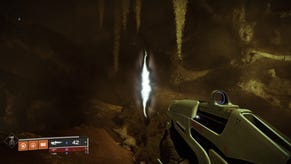Destiny: State of the Game part one - journeying towards launch
Destiny has come a long way. In this first episode of a three part series, we track Bungie's baby from conception to birth.
Destiny: House of Wolves launches next week, bringing huge changes to the ever-evolving shared-worlds shooter and cementing the gameplay of Destiny: Year One. To celebrate the release of this second expansion, and the maturation of the project, we're going to be publishing a series of feature articles under the banner Week of Destiny.
Today we're going to kick things off with a look back at Destiny's slow assault on the games industry, growing from whispers and rumours to one of the biggest launches of the past decade.
Bungie's first follow-up to Halo was always going to be huge, no matter what it was, but looking back over its history one of the most impressive aspects of the whole affair is just how deep its roots go.
The absolute beginning of Destiny, from an outsider's perspective, was Bungie's 2007 split with Microsoft just one month after the release of Halo 3. Although the developer remained committed to Halo, producing and supporting Halo 3: ODST and Halo: Reach, it was clear that it had its sights on something new. The movement of key Halo personnel like Frank O'Connor to 343 Industries, an internal Microsoft studio raised in Bungie's shadow to eventually inherit the property, was proof enough for fans.
It wasn't until 2009 that Destiny tipped its hand, though, placing a teaser in Halo 3: ODST - the phrase "Destiny Awaits", and an image we now know to be the Traveller. Bungie was very coy about this teaser, although in retrospect it seems obvious that it had revealed what would eventually become the working and final title for what was then still known internally as Project Tiger.
In one of the most discussed business deals of the last decade, Bungie signed a ten year publishing agreement with Activision for its "next big action game universe", announcing the deal in April 2010. Everyone was hugely excited by the prospect of Bungie remaining indie and going multi-platform, including Sony - which will be important later.
Over the next few weeks and months Bungie gave us some slim details of its vision - it expected to produce an IP that would last for multiple console generations, and was careful never to flatly turn down the descriptor "MMO". At this stage the concept was fleshed out enough that Bungie wasn't against showing it at that year's E3 - although that did not pan out.
Other details leaked from various sources in the following months. We heard the new game would be an action RPG (correct) and that it would have persistent online progression (correct), and Activision dropped heavy hints that online connectivity would be part of its vision from the start (correct) - something Activision was able to support with its own matured online services suite.
In February 2011, leaks revealed that Destiny, well, was called Destiny - and that it would be a shooter MMO - the famous "WoW in space". By May the title still wasn't officially confirmed, but trademarks pretty much guaranteed it in our mind, and we got a first look at the tricorn logo. In August 2011, Bungie published a 20th anniversary documentary which showed a few tantalising snippets of development - motion capture and environmental renders.
There were two major information dumps to come before Activision and Bungie officially pulled back the covers, the first of which was entirely above board.
Although the Activision deal had been in the works for nine months before announce, it was revealed within a month of the great Infinity Ward exodus which eventually led to the formation of Respawn Entertainment and a vicious lawsuit between Activision Blizzard, EA and former Infinity Ward members. It was this lawsuit that gave us a picture of what Bungie had planned for Destiny.
According to details of the contract between the two companies, which was already out of date by the time of its publication in May 2012, Destiny was to be an Xbox exclusive "action shooter" launching in 2013, with multi-platform sequels to follow every two years thereafter, for a series of four games. Major expansions, codenamed Comet, would release on alternate years.
It's interesting to note that this initial contract, and Activision Blizzard financial documents dating back to the contract's announcement, show Destiny as coming to PC, but make no specific mention of next-generation consoles.
While several details of this contract turned out to be out-of-date, Bungie good-humouredly confirmed that at least one was on the money (and ironically, was later proved incorrect). "See you starside in 2013," the developer said, cheekily half-confirming a sci-fi setting and anticipating a launch date it would absolutely miss; just days later it would confirm it was skipping E3 2012.
We got a few more minor hints before the next major information drop. Bungie released a Destiny t-shirt, which wasn't super subtle, and a new hire confirmed sandbox elements. A significant leak revealed co-operative multiplayer and shared-world server infrastructure.
Then, the big one: in November 2012, almost two full years before Destiny's launch, a bunch of third-party produced marketing documents made their way into the wild. Bungie ruefully confirmed the documents as genuine, while stressing that they weren't necessarily up to date, or meant for external use.
The leak included a batch of concept art, some of which dated back to a time when Destiny was envisioned as more high fantasy than sci fi in order to differentiate it from Halo, and the text of the documents made several references to the family-friendly nature of the content, which upset some mature Bungie fans almost as much as the reference to the game being "social at its core".
“Destiny is designed for your inner seven year old. We want to make it feel like a mythic adventure,” the advertising firm wrote, suggesting players would experience “a world to explore with friends, both old and new”. Dissatisfaction with these aspects, which did not go down well with old-school single-player Halo fans, was not helped along by continued silence on the project.
Finally, in early 2013, Bungie decided it was ready to talk about Destiny. Following some lighthearted teases, it announced the title and a reveal date, eventually debuting the project to the public with a documentary, and confirming a 2014 launch on consoles, but not PC. (Side note: a PC build has never been entirely ruled out, but we also haven't heard a whisper of it since April 2014.)
Although it continued to give interviews and presentations, Bungie did not actually show (or even tell) much of Destiny for some months yet - something which didn't go uncriticised. Looking back on it, this may have been because even after something like three years in development the project wasn't entirely locked down. For months after the initial reveal, we heard things that didn't quite pan out the way we expected - like talk of episodic content, in-game matchmaking, and race- and class-specific narratives. Looking back at the first proper reveal of Destiny in action at E3 2013, it's easy to spot a number of features that were tweaked, dropped or perhaps never implemented beyond this demo build.
Some of the features players were disappointed not to see in the final release of Destiny were the products of imagination and speculation rather than failed promises, while others (episodic story content and ships appearing in-game) were either discussed in interviews or featured in promotional materials. For example, it's quite clear from cinematic sequences shown in promotional materials that the story went through some significant changes; the character we now know as the Awoken Queen's brother was once called the Crow, and appeared on Earth - perhaps in a similar role to that occupied by the Exo Stranger in the finished game. Speculation regarding even more significant, late-stage changes to the project weren't precisely quelled by the fact that Destiny lead writer Joe Staten took to his heels, later followed by Josh Rubin.
Changes of direction, even significant ones, frequently occur even quite late in development (at one stage, Destiny was going to be third-person!), and that's one of the reasons why games PR is locked down so tightly; nobody wants to "promise" and then not deliver.
As a result of Bungie's probably sensible silence, it was months before we really began to understand what Destiny would be like to play, receiving initial details on story missions, Strikes, Patrol, Bounties, Crucible, Raids, public events, character customisation, progression, the stripped back UI, server infrastructure and seamless multiplayer instance transitions. It was hard to see how it all fit together, but many fears were laid to rest (and new hearts won) during the project's alpha and beta tests.
Both tests were hugely popular, and the beta in particular was enormous; Bungie said it was aiming for 1 million simultaneous players, and managed that number with aplomb, because it was treating the test like a full launch. Of course, the tests also spawned their share of criticism - oh, Dinklebot - but in general it served not just as a partial explanation for Destiny's admirably smooth launch but also for the overwhelming hype.
Destiny's launch on September 9 2014 was preceded by tremendous anticipation driven by savvy and widespread promotion. Early on, Activision's description of its publishing deal as a "landmark" and the project as "incredible" was an early clue the publisher intended to go gangbusters on the new product.
Activision made one of the largest ever new IP investments on Destiny, eventually pouring $500 million - half a billion dollars - into its development and marketing, with marketing making up the larger proportion. Sony chipped in as if the shooter were a first-party effort, too, which definitely paid off - although Microsoft stayed upbeat about it.
Destiny was the most pre-ordered new IP in gaming's history, and Activision shipped $500 million worth of stock to retailers in very short order. Critically, things didn't pan out so well - press weren't given early access, and Bungie knew that the nature of the game would make for dodgy first-day reviews. When the dust settled, we were left with a Metacritic of 76 on PS4 - way too low for what was believe to be the largest Metacritic bonus ever written into contract. The resulting debates renewed interest in questions of the value of reviews and the changing nature of games and their audience.
Despite the anger of vocal comment sections (hi, y'all), huge numbers of players flocked to Destiny - and continue to do so. But we'll talk about that tomorrow, as we continue our Week of Destiny coverage leading up to the launch of House of Wolves.













.jpg?width=291&height=164&fit=crop&quality=80&format=jpg&auto=webp)



